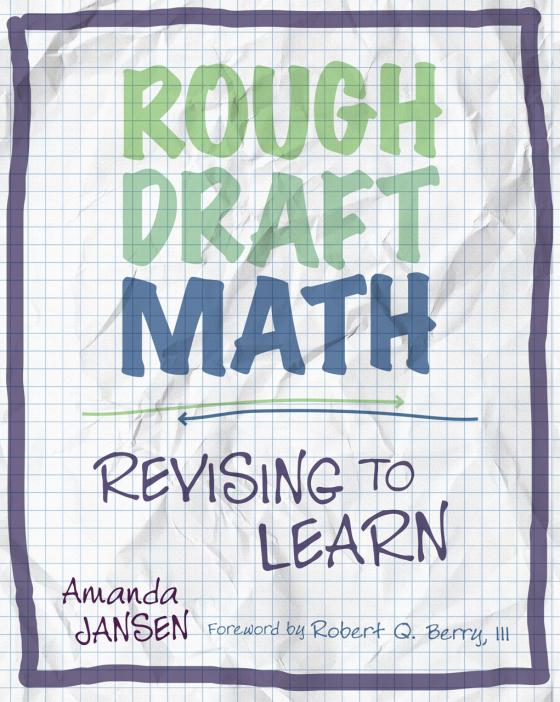You alluded to how speed is often seen as the marker of math success. What are some other ways of being smart in math that can be highlighted via rough draft thinking?
Jansen: You can ask a question about someone else's thinking, and it could help the whole class learn something more. You can notice how two people's ideas are related, and then you're making a new connection. You can represent somebody else's thinking in a new way, like a drawing or a graph. You can write an explanation that makes more sense to the class than what the teacher's explanation communicated. So there are all kinds of ways that the students can then contribute to help the whole class learn more that's not about getting an answer correct quickly. And those ideas are not new for rough draft math. They're really rooted in the ideas of complex instruction.
 Your book takes us inside some classrooms to show how teachers facilitate students sharing solution strategies before they've refined them. How does this benefit both the speaker and the listener?
Your book takes us inside some classrooms to show how teachers facilitate students sharing solution strategies before they've refined them. How does this benefit both the speaker and the listener?
Jansen: The speaker is benefiting in a few ways. Every time we're being asked to articulate our thinking we make new connections or crystallize our ideas just by trying to put them into words or trying to put them into writing. And the class is going to try and make sense out of what they shared, so then they have that experience of their ideas being taken seriously in the community. Hopefully multiple people are asked to share and there's a conversation about that person's thinking, so who’s the speaker and who's the listener should start shifting pretty quickly. But if you are listening in whatever moment, you're benefiting because you're thinking about what they said, you may get a new perspective on how to think about an idea that you hadn't thought about before. You might feel validated, as if, “Oh, this person thinks in ways that are similar to me.” You could feel challenged. And you could feel interested in helping that person revise.
The book also includes different methods for enabling students to revise their work and to reflect on their revisions. Why is reflection important?
Jansen: There's a phenomenon that when you understand something new and you develop a deep understanding for it, you feel like you've always known it. Honoring that history of how the idea came to evolve helps you when you hit a new topic that's very amorphous and challenging to understand. It normalizes and reminds you about the ongoing learning process. At the same time, I think it creates this sense of intellectual connection to the other people in the room. You realize that we all need each other, that it's a great opportunity to be able to learn with other people.
How might these practices improve racial, gender or socioeconomic equity in math classrooms?
Jansen: There may be students who are consistently seen by their peers as not being academically strong in whatever way. Sometimes those ways of seeing their peers might fall under racial lines or gender lines. And if, through rough drafts, everyone's ideas have strengths in them and the teacher points out what's valuable about the drafts, and then their peers start to point out what's valuable, then everyone is seeing each other as having some mathematical strengths. That's a powerful thing that we should all be doing for each other all the time.
There are things to be concerned about so we don't create additional equity dilemmas when we're dealing with rough drafts. One is whose work is being positioned as being rough, and whose work is being positioned as more refined. So I started keeping track in my own class with a clipboard: Who is being called upon in what time in the lesson? Are we only calling on girls in the rough drafts or positioning Black or brown students as having rough draft thinking? They can also have brilliant, refined thinking and we need to make sure not only are they having a voice, but their strengths are being really looked at.
Rough draft math involves more discussion of problems than many of us experienced in math class. How does this work out for quiet kids?
Jansen: I think that also rough draft math should involve writing. A lot of the revision practices are individual. So there is a lot of discussion with rough draft spaces, but there's also these built-in individual revision opportunities that everyone should be experiencing because individual writing is also the space where your thinking continues to grow. However, when I have (quieter students), I do gently challenge them to share, because if they aren't sharing in the public space, their colleagues are missing out on their ideas.
What differences do you see in students’ affect and engagement when they feel safe to refine and revise their thinking?
Jansen: People show up with this sense of just feeling happy to be there. They are uniquely interested in each other's thinking because they know that they're learning in community to develop ideas together. They are more likely to just put something out there, whether it's in the group work that they're working on or coming up to the document camera to share their thinking. There's less waiting for a student to volunteer. There just seems to be a little less stress. People also tend to feel proud. If someone's recognizing that their ideas helped them, they feel this sense of pride.
What are some of the barriers to teachers adopting this approach?
Jansen: If you've never experienced a space that encourages those ideas, that's hard to recreate. If you do have this vision rooted in some experiences, what takes more time for folks is building in revision experiences. At first it’s the initial setting up of revision expectations that takes more time. Then, over time, adding in the revision isn't as much work. It takes less time than we think it will after we do this many times with students. And teachers I have known have used rough drafts with honors classes, with classes that have a lot of special education students, English language learners, and they’ve reported benefits.
What can rough draft math look like in online teaching?
Jansen: (For synchronous learning), you can do a lot of communicating to students that their ideas are valuable and making sure you're helping them elicit the drafts. A lot of people have had success using Google slides where you can still put the students in small groups to write up their thinking and then have the groups look at each other's slides and talk in the in the whole group and then go back and revise your slides and then write in the notes how you changed your ideas and why. You can even, at the end of class, have them write a Google form reflection about how their thinking changed and why. For asynchronous, I've seen folks have some success using discussion boards. So essentially the principle of giving people the opportunity to share their first thinking and then revise it. You can imagine different structures online that people have had success with. But it's also a lot of us, this year, we knew folks face to face for a period of time before we went online. So now people are talking about what does it take to set up the classroom culture when we may need to be online from the beginning? What kinds of relationship building experiences do we need to do?
How can teachers apply the principles of rough draft thinking to how they reflect their own successes and failures in the classroom?



